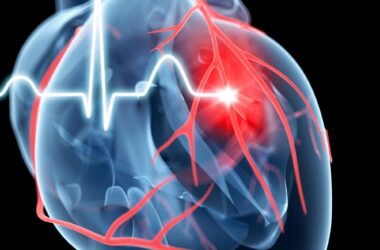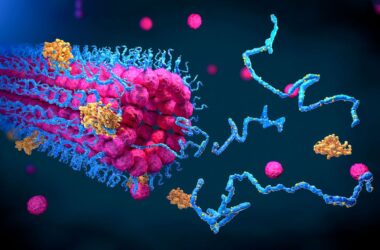
Les chercheurs ont découvert un changement dans le coronavirus canin qui indique un modèle possible de changement trouvé dans d’autres coronavirus et peut fournir des indices sur la façon dont ils se propagent des animaux aux humains.
Les scientifiques de Cornell ont identifié un changement qui se produit dans le coronavirus canin qui indique un modèle possible de changement trouvé dans d’autres coronavirus et qui peut fournir des indices sur la façon dont ils se transmettent des animaux aux humains.
Un nouveau coronavirus canin a été identifié pour la première fois chez deux patients humains malaisiens qui ont développé une pneumonie en 2017-18. Un groupe d’autres scientifiques a isolé le coronavirus canin, l’a séquencé et ont publié leurs résultats en 2021.
Une équipe dirigée par des scientifiques des universités Cornell et Temple a découvert un motif qui apparaît dans la terminaison de la protéine de pointe du coronavirus canin – la partie du virus qui permet l’entrée dans une cellule hôte : Le virus passe de l’infection des intestins et du système respiratoire de l’hôte animal à l’infection exclusive du système respiratoire de l’hôte humain.
Les chercheurs ont identifié un changement dans le terminus – appelé terminus N – une région de la molécule présentant des altérations également détectées dans un autre coronavirus, qui est passé des chauves-souris aux humains, où il provoque un rhume.
L’article intitulé “Recent Zoonotic Spillover and Tropism Shift of a Canine Coronavirus is Associated with Relaxed Selection and Putative Loss of Function in NTD Subdomain of Spike Protein” a été publié le 21 avril 2022 dans la revue MDPI. Virus.
“Cette étude identifie certains des mécanismes moléculaires qui sous-tendent le changement d’hôte du coronavirus du chien vers un nouvel hôte humain, et qui peuvent également être importants dans la circulation d’un nouveau coronavirus humain que nous ne connaissions pas auparavant”, a déclaré Michael Stanhope, professeur de santé publique et de santé des écosystèmes au Collège de médecine vétérinaire. Le premier auteur, Jordan Zehr, est un étudiant en doctorat dans le laboratoire du co-auteur, Sergei Kosakovsky Pond, professeur de biologie à l’Institut de génomique et de médecine évolutive de l’Université Temple.
Dans cette étude, les chercheurs ont utilisé des outils d’évolution moléculaire de pointe développés dans le laboratoire de Pond pour évaluer comment les pressions de la sélection naturelle ont pu influencer l’évolution du coronavirus canin.
Chez l’homme, le principal récepteur auquel se lie la protéine de pointe de l’Alphacoronavirus (le genre auquel est classé le coronavirus canin) pour pénétrer dans une cellule humaine est appelé APN, mais il existe également des corécepteurs. L’un de ces corécepteurs est l’acide sialique acid, which is found in gastrointestinal cells in a variety of mammals. The researchers identified a region of the spike protein in the N-terminus called the O-domain, which is known for binding with sialic acid. In the analysis of the canine coronavirus found in the Malaysian patients, parts of the O-domain were changing in unique ways.
The canine coronavirus found in the Malaysian patients appeared to be in the process of losing its O-domain – but not completely. “But it has a molecular evolution history that suggests that the sialic acid binding region is no longer doing the same job,” Stanhope said. The researchers found evidence of “relaxed evolution,” where the pressures of natural selection become reduced, which facilitated the shift.
The researchers compared this shift and loss of the O-domain to other related coronaviruses. One, called transmissible gastroenteritis virus (TGEV), infects pigs and causes respiratory and intestinal disease. A variant of this pig virus, called porcine respiratory coronavirus, is almost identical to TGEV, but it has lost its O-domain and is entirely a respiratory pathogen. Similarly, a coronavirus known to cause common human colds originated in bats as a gastrointestinal virus, lost its O-domain, and jumped to a human host as a respiratory virus.
“So this is a pattern that seems to be repeating itself in coronavirus evolution and in particular in coronavirus evolution associated with these tropism shifts, where we go from a gastrointestinal infection originally and then jumping to an alternate host, where it’s now respiratory,” Stanhope said.
The same variant of canine coronavirus found in Malaysia was also reported in 2021 in a few people in Haiti, who also had respiratory illness. More study is needed to understand if the viral shifts and jumps to humans occurred spontaneously in different parts of the world or if this coronavirus, which would represent the eighth known human coronavirus, has been circulating for perhaps many decades in the human population without detection, Stanhope said.
The N-terminus domain of SARS-CoV2, which causes COVID-19, is receiving increasing attention from researchers, and this study provides additional rationale to focus on this specific area of the molecule.
Reference: ” Recent Zoonotic Spillover and Tropism Shift of a Canine Coronavirus Is Associated with Relaxed Selection and Putative Loss of Function in NTD Subdomain of Spike Protein” by Jordan D. Zehr, Sergei L. Kosakovsky Pond, Darren P. Martin, Kristina Ceres, Gary R. Whittaker, Jean K. Millet, Laura B. Goodman and Michael J. Stanhope, 21 April 2022, Viruses.
DOI: 10.3390/v14050853
Co-authors include Laura Goodman, assistant research professor in the Department of Public and Ecosystem Health and the Baker Institute for Animal Health; Gary Whittaker, professor of virology in the Department of Microbiology and Immunology; and Kristina Ceres, a doctoral student working closely with Stanhope and Goodman. Goodman and Whittaker are both part of the Cornell Margaret and Richard Riney Canine Health Center.
The study is funded by the U.S. Food and Drug Administration’s Veterinary Laboratory Investigation and Response Network and the National Institutes of Health.



